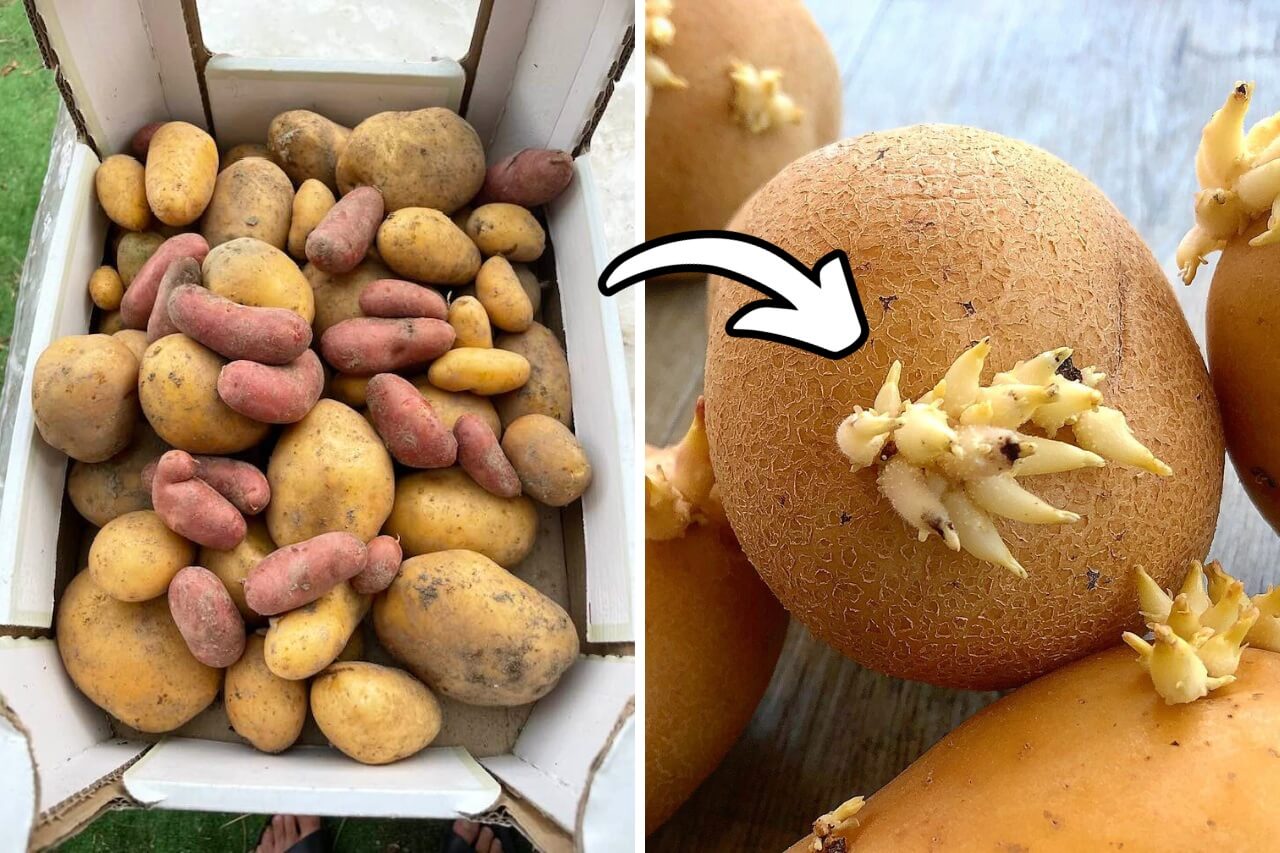It’s always a disappointing thing when you reach into your pantry for potatoes, but you find them with those little “eyes” and pale shoots growing out.
Don’t get me wrong, potato sprouting is a very common problem in every house in the world. However, it’s important to consider that not only does it make your spuds look unappetizing, but it also affects their quality.
Generally, sprouted potatoes become soft and wrinkly, and they can develop a bitter taste or even mild toxins in the sprouts that you don’t want to eat.
Fortunately, with a bit of knowledge and a few clever tricks, you can keep your potatoes fresh, firm, and sprout-free for much longer.
This means less food waste and better-tasting potatoes, no matter what climate you live in or season you’re in.
Why Do Potatoes Sprout in the First Place?
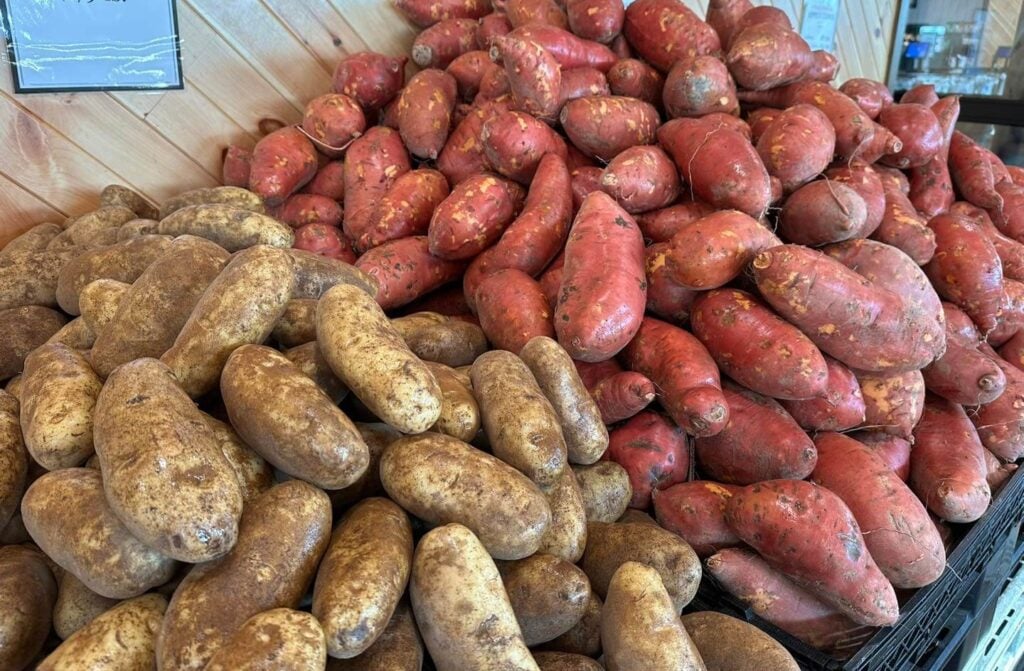
To outsmart potato sprouting, it helps to understand why it happens.
Sprouting is a natural part of a potato’s life cycle. Essentially, the potato is trying to grow into a new plant.
Potatoes have an inherent dormant period after harvest, but warm temperatures and light can trick them into “thinking it’s spring” and break their dormancy.
In a warm, bright environment (anything above about 65°F/18°C with exposure to light), the eyes of the potato will start to grow shoots.
Remember that even under perfect storage conditions – cool, dark, well-ventilated – given enough time, potatoes will eventually sprout once their natural dormancy fades.
However, improper storage significantly accelerates this process. Think of heat and light as a green light for your potatoes to start growing.
So, our mission is to create conditions that tell those spuds “not yet” and keep them in culinary hibernation.
Another reason potatoes sprout (and turn green) is exposure to light. Light doesn’t just wake up the eyes; it also causes potatoes to produce chlorophyll and bitter toxins near the skin.
That’s why potatoes stored in sunlight often turn green and sprout at the same time.
It’s nature’s way of signaling the tuber to grow (and warning us that green parts aren’t great to eat). By understanding these triggers – warmth and light – we can now move on to preventing them.
Create the Ideal Potato Storage
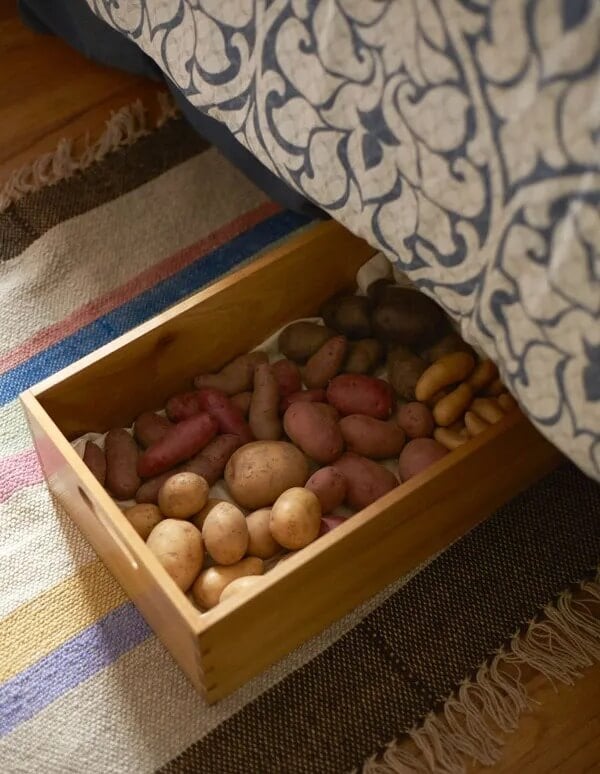
As you probably already know, the number one rule to prevent sprouting is to store potatoes in a cool, dark, and dry place.
But let’s take a closer look at how to actually create an ideal environment.
You should essentially try to replicate the underground environment that potatoes love.
Aim for a temperature that’s cooler than typical room temperature but not freezing – about 45°F to 50°F (7°C to 10°C) is often cited as ideal.
Under these conditions, potatoes can remain dormant for a long time. In fact, potatoes stored around 45-50°F in darkness can last up to three months or more without sprouting, whereas on a warm kitchen counter (around 70°F) they might start sprouting in just a couple of weeks.
Heat will dehydrate potatoes and trigger sprouts quickly, so finding the coolest spot in your home is key.
For many people, a basement or cellar is perfect because it stays cool and dark. If you don’t have a basement, consider an unheated closet, a pantry away from appliances, or even an insulated garage during cooler months.
In an apartment, you might dedicate a cabinet or a low shelf in the pantry for potato storage – the lower to the ground, generally the cooler it will be.
Some folks even use a clay pot or styrofoam cooler as a makeshift root cellar: the insulation helps maintain a stable cool temperature. Just be sure there’s some airflow (don’t seal it tight). Which brings us to the next point: ventilation.
Potatoes “breathe” and release moisture, so they need ventilation.
For this reason, remember to store them in a container that allows air circulation. Some good ideas can be a burlap sack, a mesh or perforated bag, a basket, or a simple cardboard box with some holes.
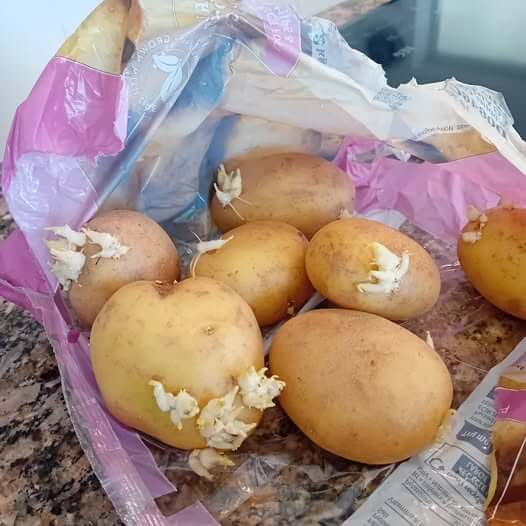
A mistake I often see is leaving them in plastic. If your potatoes came in a plastic bag, you should immediately transfer them out of it.
Plastic traps moisture and can lead to condensation, mold, and faster spoilage.
Instead, use a breathable material like a paper bag or a cloth sack. If you’re looking for an easy method, just take a paper grocery bag, punch a few holes for extra ventilation, and put your potatoes in there.
This keeps light out but lets air in. And please never wash potatoes before storing, as moisture is always an enemy in veggie storage.
If they’re garden potatoes and there is some soil, just brush off excess dirt with a brush or cloth.
Mind the Company They Keep
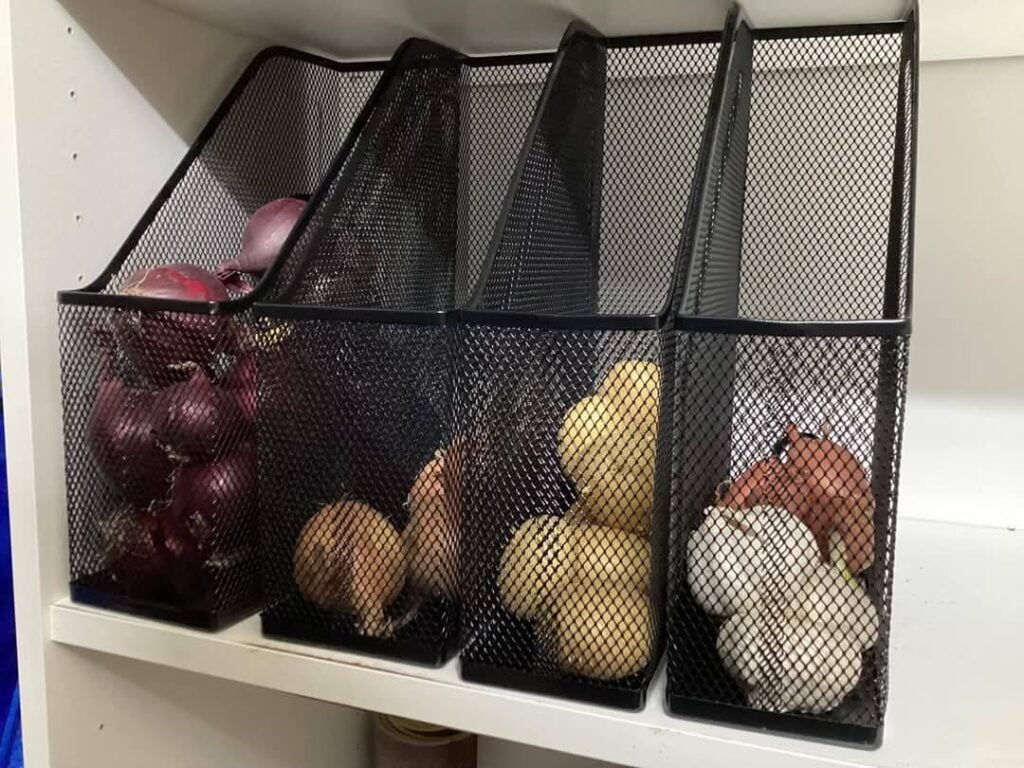
You might be tempted to stash all your produce together, perhaps also due to a lack of space, but potatoes need to be stored away from certain fruits and vegetables.
The biggest no-no is storing potatoes alongside onions. Why? Onions give off ethylene gas, a natural plant hormone, which can cause potatoes to sprout and spoil faster.
In return, potatoes are quite moist and can make onions rot quicker, so they really are bad roommates.
The classic tip is to keep onions and potatoes in separate corners of your pantry, and if you have a hanging wire basket system, don’t put them in the same basket or the tier right above/below each other. Give them some distance.
Potatoes also don’t get along with ethylene-producing fruits like apples, bananas, or tomatoes – at least not if you’re trying to slow down ripening and sprouting.
As I’ve just said, ethylene generally accelerates the aging and ripening of produce. However, this is where it gets interesting: there’s a clever trick that turns this rule on its head, which we’ll discuss in a moment (hint: it involves one of those fruits).
But as a general storage practice, keep your potatoes in their own cool, dark zone, away from the fruit bowl and away from the onion bin.
This separation alone can add extra shelf-life to both your potatoes and those other veggies.
The Apple Trick (and Other Surprising Natural Remedies)
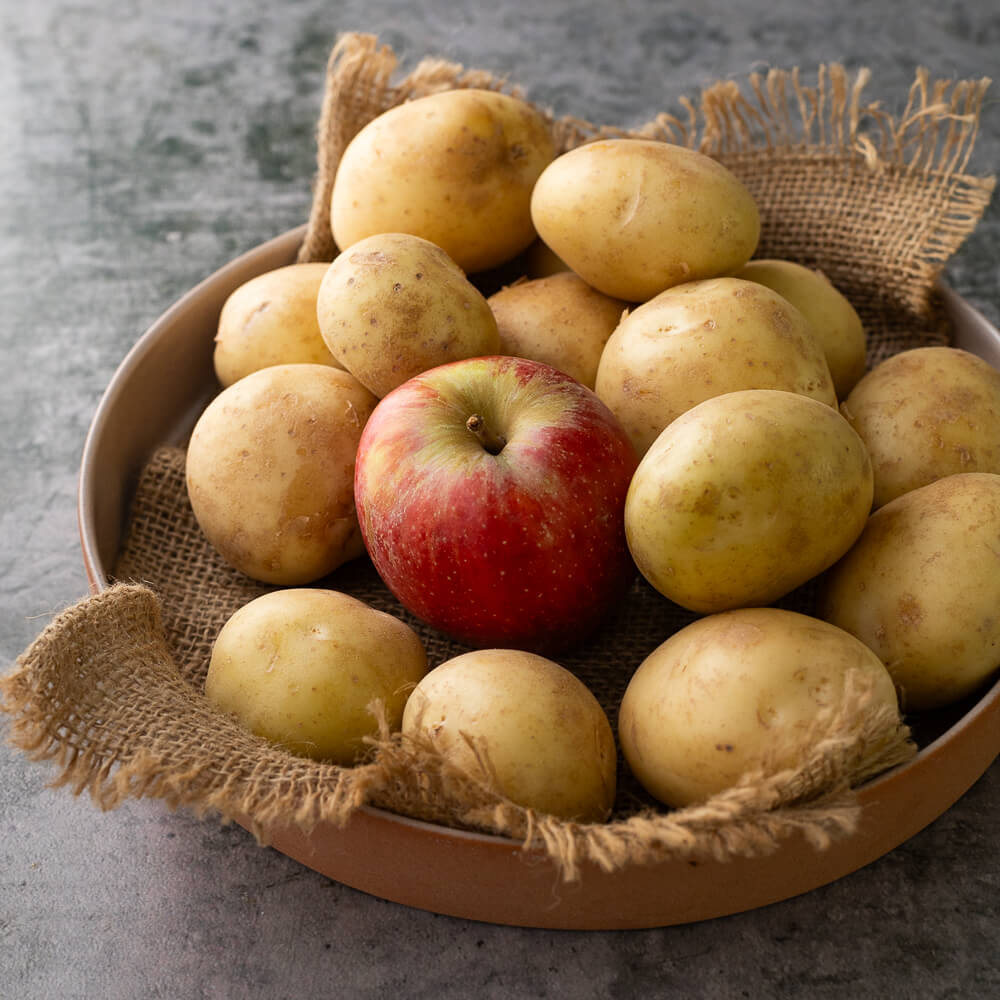
You may have heard an old kitchen trick that sounds counterintuitive: placing an apple in with your potatoes to prevent sprouting.
For years, home cooks have sworn that a single apple can keep potatoes fresh longer. The idea is based on the same ethylene gas we just warned about.
It turns out that in certain conditions, a tiny amount of ethylene gas might actually inhibit sprout formation in potatoes.
Scientific studies have shown that exposing potatoes to a controlled dose of ethylene can delay sprouting for a while. This has intrigued even big potato storage companies, especially after some traditional anti-sprout chemicals were banned.
So, does the apple trick really work? The answer is sometimes – your mileage may vary.
In a lab, ethylene gas can be measured and timed precisely to stunt the sprouts. In your pantry, it’s a lot less predictable.
One food writer even ran a home experiment: she stored one batch of potatoes with an apple and one batch without. Funny enough, the bag with the apple sprouted just a day before the bag without the apple.
Not exactly a dramatic difference. However, another anecdote (from a science fair project, no less) found that putting a banana with potatoes worked better than an apple, likely because bananas release more ethylene.
The bottom line from experts: there’s no harm in trying – an apple or banana in the potato bag might delay sprouting a bit, and it won’t hurt your potatoes.
Just don’t rely on it as your only method or expect miraculous results. If you do try this trick, make sure the apple is in good condition (if it rots, that’s a new problem) and consider that you may want to replace the apple every couple of weeks.
It’s a neat natural hack that costs nothing, so feel free to experiment, but good storage conditions are still your main defense.
Another trick comes from grandmothers and gardeners in warm climatesthe and it0s the newspaper wrap. It’s a bit old-fashioned, but it’s inexpensive and worth a shot if you struggle with sprouting.
Try wrapping each potato in newspaper and then placing them in a breathable box or basket under a bed or in a cool closet.
The newspaper blocks light and also creates a small buffer between potatoes so they don’t touch each other.
This can prevent the “chain reaction” of one sprouting or rotting potato affecting its neighbors.
Also Read: Vegetables That Grow Well in Shady Gardens
Adapting to Your Climate
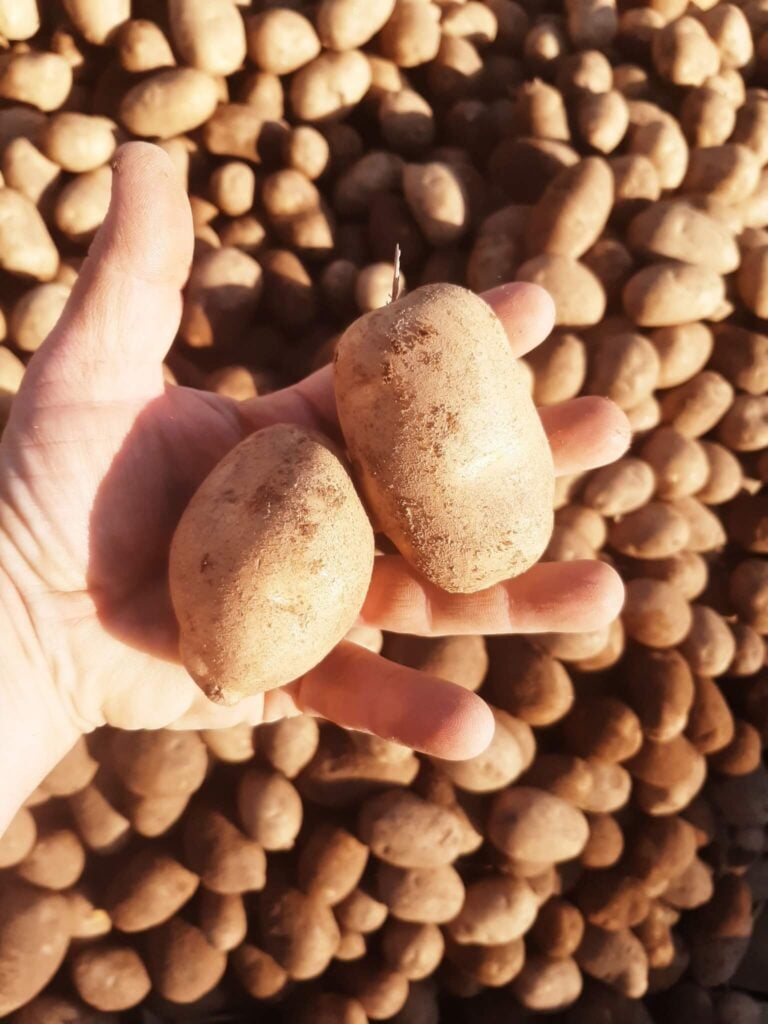
Storing potatoes can be particularly challenging if you live in an area with consistently high temperatures or high humidity.
Refrigeration – Yes or No? Traditionally, we’ve been told not to refrigerate potatoes.
The reason was that fridge temperatures (usually around 35-40°F or 1-4°C) could convert potato starch into sugar, leading to overly sweet, oddly browning potatoes when cooked.
There were also concerns about acrylamide (a potential carcinogen) forming during high-heat cooking of chilled potatoes.
However, new research has challenged this old advice. In fact, the UK’s Food Standards Agency now says it’s safe to keep potatoes in the fridge, and doing so can significantly extend their shelf life by 3 to 4 months.
This is big news for people in hot climates. If your choice is between potatoes sprouting in a week on the counter or lasting a few months in the fridge, you may opt for the fridge.
To minimize any negative effects, you can take the potatoes out of the refrigerator a day or two before using them, letting them warm up slightly; this can reduce sweetness if it developed.
Also, focus on cooking methods like roasting, boiling, or mashing rather than high-temp frying if you’re concerned about acrylamide, which is mostly an issue for deep-frying.
Remember That One Bad Potato Spoils the Bunch
Finally, an important practical tip no matter where you store your potatoes: check on them regularly.
Make it a habit to inspect your stored potatoes once a week (or every few days in warm weather).
If you spot any early sprouts, pinch them off to slow the sprouting process. More importantly, if you find a potato that has gone bad – it might be mushy, leaky, or moldy – remove it immediately from the batch.
As the saying goes, one bad apple (or potato) can spoil the bunch. A rotting potato releases moisture and can spread decay or encourage others to sprout in response.
By culling the bad ones, you’ll protect the rest of your stash.
Also, separate any that have green skins or bigger sprouts to cook those first (after trimming off the green/sprouts) while they’re still usable, and keep the good ones for later.
ALSO READ: How to Grow Sweet Potatoes at Home with Containers Gardening

